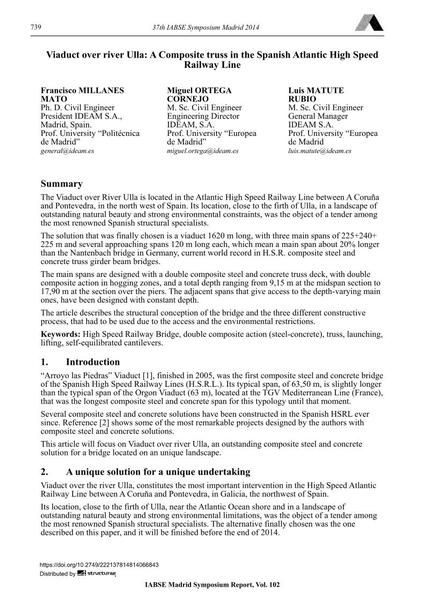Viaduct over river Ulla: A Composite truss in the Spanish Atlantic High Speed Railway Line

|
|
|||||||||||
Détails bibliographiques
| Auteur(s): |
Francisco Millanes Mato
Miguel Ortega Cornejo Luis Matute Rubio |
||||
|---|---|---|---|---|---|
| Médium: | papier de conférence | ||||
| Langue(s): | anglais | ||||
| Conférence: | IABSE Symposium: Engineering for Progress, Nature and People, Madrid, Spain, 3-5 September 2014 | ||||
| Publié dans: | IABSE Symposium Madrid 2014 | ||||
|
|||||
| Page(s): | 739-745 | ||||
| Nombre total de pages (du PDF): | 7 | ||||
| Année: | 2014 | ||||
| DOI: | 10.2749/222137814814066843 | ||||
| Abstrait: |
The Viaduct over River Ulla is located in the Atlantic High Speed Railway Line between A Coruña and Pontevedra, in the north west of Spain. Its location, close to the firth of Ulla, in a landscape of outstanding natural beauty and strong environmental constraints, was the object of a tender among the most renowned Spanish structural specialists. The solution that was finally chosen is a viaduct 1620 m long, with three main spans of 225+240+ 225 m and several approaching spans 120 m long each, which mean a main span about 20% longer than the Nantenbach bridge in Germany, current world record in H.S.R. composite steel and concrete truss girder beam bridges. The main spans are designed with a double composite steel and concrete truss deck, with double composite action in hogging zones, and a total depth ranging from 9,15 m at the midspan section to 17,90 m at the section over the piers. The adjacent spans that give access to the depth-varying main ones, have been designed with constant depth. The article describes the structural conception of the bridge and the three different constructive process, that had to be used due to the access and the environmental restrictions. |
||||
| Mots-clé: |
pont ferroviaire à grande vitesse
|
||||
